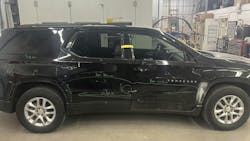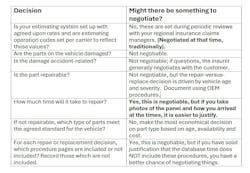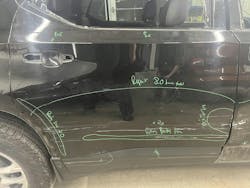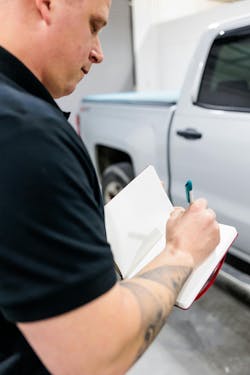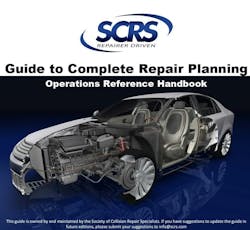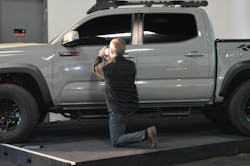As fleets, leasing companies, and insurers move toward reducing severity, it is important to be able to justify the estimate lines to negotiate a fair settlement for a safe and proper repair. This article reviews the types of justification necessary throughout the repair plan to ensure it passes the review these carriers put our estimates through as they adjust the claims.
Our Opportunity
One of the services offered by estimating trainers/consultants is to review a few of their in-process estimates — and see what opportunities are missed — to help JUSTIFY getting repairers paid for work performed. The variation in values can often be stunning when you consider they often can add 30-50% of total labor hours or 40-80% more in average RO cost to a vehicle that has been repair-planned. This article will attempt to provide a logical way to consider the decisions made which can contribute to writing a complete estimate.
Meanwhile during COVID, insurers/repairers got into “processing mode” and weren’t scrutinizing estimates as closely. Now that claims are down 10-12%, the estimating systems’ audit review expected score has dropped from 1,000 to 250. The remote claims representatives are therefore questioning more charges or even denying payment for some unjustified procedures. Often, these things will be paid for if you can JUSTIFY the charges.
These two opposing perspectives now are forcing estimators to up their game on justification of charges. At the same time, it really incentivizes them to learn to provide sufficient documentation to support the charges on nearly every negotiable line of an estimate.
Understanding What is Negotiable When Estimating
Mel Hunke, a shop owner from Nebraska, taught estimating 3M ARM$ estimating workshops for years. He created a simple decision tree (which I have updated herein) to assist when inspecting repairs, and these decisions minimized the friction by isolating the limited number of repair procedures which disagreement may occur.
As you can see, if you remove the noise of the non-negotiables there are often only three to five lines, relative to the repair judgment times and related P-page items and times per part, that are negotiable. With proper justification (using estimate line notes or documentation), those negotiations can be minimized and friction avoided.
Remember, with justification, you don’t have to have a WIN-LOSE negotiation. Often, the person from the payer merely needs proof that the procedures are JUSTIFIED. To properly JUSTIFY, use extensive line notes, attaching a PDF of documents, or use a documentation tool like DCR’s Collision Clarity to justify the decisions on each estimate line. We will look at things you can use to justify your negotiated times in the rest of the article.
Research OEM Procedures and Pre-Scan
Before disassembly, it is advisable to perform relevant OEM research to assure parts are removed in the proper succession/process, single-use fasteners are identified, and other relevant repair techniques are known. While the vehicle is being prewashed, it’s important to perform the pre-scan. This proves all systems are performing as designed, and if not, which systems need to be repaired.
Prior to extensive disassembly and while the vehicle may still be mobile, it can be helpful to diagnose mechanical systems which may require repair. The scan report can therefore be used to JUSTIFY the repair lines, related parts can be secured, and necessary sublet can be scheduled during the repair process to minimize repair cycle time.
Per-panel Decisions
Most of us know the total loss threshold for a vehicle has dropped from 80% to 75% for many insurers. This same guideline can be applied to parts repair. Considering vehicle age and safety, you may prefer to repair many parts for up to 75% of the replacement cost to complete an economical safe and proper repair. Considering repair efficiency is 165-190% and labor gross margin is 60%+, it is often more economical to repair a part.
To justify repair times, you may JUSTIFY the repair times using something the size of a credit card for 1 hour and consider body lines and reverse lines for additional hours. To aid in JUSTIFICATION, you may want to use things like a dent ruler to show the extent of damage on a part to JUSTIFY the repair time. A rough pull may be required to verify a part can be repaired, and if you eventually replace the part, that rough pull is a JUSTIFIED repair cost.
The best way to JUSTIFY the times you are requesting is to insert an image of the vehicle with on-vehicle notes per hour or judgment time you are requesting.
Plastic Repair
During COVID, many repairers got busy and merely replaced all plastics which were damaged. Again, the 75% replacement threshold can be used when comparing repair time to buying a replacement. Shawn Ryan (3M), Scott Wheeler (Axalta), and I created a grid to help JUSTIFY plastic repair times (email me at [email protected] for a copy).
Part Replacement Times
As most of you know, the database companies no longer perform time studies on the vehicles in North America. Instead, the database supplier counts the type and number of fasteners / shields and uses math to come up with part replacement times. Contact the Database Enhancement Gateway at https://degweb.org/ to log an inquiry if you believe there is an error, and you feel you can JUSTIFY more time.
It’s up to the shop to pull those single-use fasteners, damaged fasteners, broken bulbs or fluids needed, and provide photo of the damaged part and invoice to JUSTIFY getting paid for stock parts items
Frame Time
Documentation of frame time requires you to set up and measure to verify damage does or does not exist. Installing a computerized measuring system can define which control points were moved and by how much. Those dimensions can then be compared to a grid provided by the dimensioning system company, which can be used to JUSTIFY the time required to pull the frame to within OEM specifications.
Parts Selection Decisions
Parts make up 35-45% of the repair cost and therefore are often a point of contention. Shops and insurers have relationships with various parts sourcing and procurement systems. The challenge often is that the lower cost parts take longer to secure, may or may not fit properly, or don’t yield the parts gross profit preferred. The key is to demonstrate that an effort was made to economically locate the parts necessary to complete the repair and proof of this effort can help JUSTIFY the part type selected. If a part was secured from the OEM supplier after they cost/profit matched (IT’S NEVER MERELY PRICE-MATCHED), then determine how they want that documented on the estimate and make a line note to JUSTIFY the approach.
P-page Decisions
As you document the repair or replacement decisions, it is important to know which repair procedures are or are not JUSTIFIED when completing a repair. Having ready access to the SCRS Not Included guide or per-panel reminder cards can be helpful to remind the estimator which procedures are not part of the replacement or R&I times. Often inexperienced estimators feel procedures are included in the overhaul time and don’t explore the procedures relative to the surrounding panels.
Paint Process Decisions
As body repairs are completed, and seam sealers and caulks are installed to match OE texture, it is important to pull those from your inventory system (or buy from your supplier) so an invoice can be generated to JUSTIFY get paid for these materials and time.
Weld-burn damage on adjacent panels is often undercalculated during the repair. Taking photos of the adjacent panels affected by the weld (or in-process photos) can really help JUSTIFY the prep, paint and mask time for those panels.
As with R&I times, the paint times are no longer calculated based on a time study, but rather based on the square millimeters of a “new undamaged” panel which will require paint on the front and/or the edge or back side. Therefore, making sure all parts requiring paint have been documented (and images of vehicle prior to entering the booth showing all panels prepped) can really help JUSTIFY paint time. Further, as repair panels are not new or undamaged, the body times either need to reflect time to pull the dent, fill the dent, prime the dent area and block the primer to ready the part to be in the “new undamaged” condition. If they try to limit repair time, then you're JUSTIFIED asking for block and prime time.
During disassembly, treat paint as the first part, so you consider R&I of emblems, stripes or glass which can be JUSTIFIED to complete the blend or paint process. Encourage the use of the spectrophotometer to justify the paint process used. Identifying pearl, tri- or quad-stage and other paint related processes at this time can be helpful to document and justify additional time or materials.
It is during the paint process that we can JUSTIFY getting paid for hazardous waste removal of excess paint and thinner, getting paid to plastic bag the vehicle (potentially two to three times) and when possible, for cleanup of glass or other wash and vacuum as required (often because the vehicle sits in a shop without glass or doors).
Post-scan, Calibration, and Test Drive
Once a vehicle is reassembled and vehicle systems are checked for function and compared to the estimate, you can install the scan tool to verify the repairs were performed and the vehicle’s safety systems are performing as intended. If so, then the vehicle should be test driven to ensure these systems function as the vehicle is driven. It’s only after this is complete, should we consider delivering the vehicle to the customer. IF all these things have been completed, use the post-scan report, test drive report and other documentation to JUSTIFY being paid for these things.
Repair Planning Process and Minimizing Negotiables
It was during the industry’s “let’s go lean” phase during 2000-2010 that we shined a light on 100% disassembly to minimize second and third supplements and attempted to write a complete and accurate repair plan. Repair-planning helps repairers review each part as it goes through the above decision tree and allows us time to justify charges, document to minimize the negotiations on estimate lines, and then work with the technician completing the repair to verify the JUSTIFICATION.
Auditing
Once the repair plan is written and well justified, the repair planner needs to audit the final repair plan versus the DRP, fleet, dealer, or other agreements which may apply. Further, you need to be comfortable that if you didn’t receive another supplement on this repair, that you would be compensated.
Conclusion
The process of writing a repair plan is as complex as the vehicle makeup. Equally as important is JUSTIFYING getting paid to return those complex systems to the same, shape, form and function as the OEM supplier. We hope this article has given you some insights as to how to JUSTIFY getting paid for performing these tasks.
About the Author
Steve Trapp
Steve Trapp is an internationally known consultant and speaker. His family operates a collision repair center in Wisconsin. He earned a degree in economics education and a minor in accounting from the University of Wisconsin.
After college, he worked for 3M in sales and marketing roles with the innovative 3M ARM$ training and software sales. He worked as a consultant for AutocheX doing financial consulting for a few years before joining AkzoNobel, where he started the industry’s first value-added program. While there, he started the industry’s first paint company-sponsored 20 groups and wrote numerous training programs with third-party experts on finance, marketing, selling, leadership, and other topics.
He later joined DuPont/Axalta, where he worked with Mike Anderson to manage their 20 groups and industry seminars. While at Axalta, he managed the North American Strategic Accounts SAM team and later the entire EMEA Strategic Accounts team. He followed that as senior consultant for LEAP, a global consulting firm that has presented in 10 countries and now again works for a major paint company.
